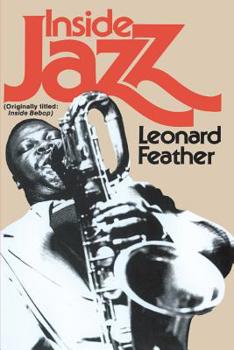Inside Jazz (Roots of Jazz)
Select Format
Select Condition 
Book Overview
By 1940 the big band sound had grown stale, and jazz musicians began to search out new sounds and styles. At the Harlem nightclub Minton's Playhouse, a small group of musicians -- John Birks, Dizzy Gillespie, Coleman Beau Hawkins, and Thelonious Monk, among sounding blend of flatted fifths, unfamiliar chord lines, and accelerated offbeat rhythms. They were joined on 52nd Street by alto saxist Charles Bird Parker, and bop -- or bebop, as it was first called, from the triplet figure buh-BE-bop -- was born. Bop was aggressive, provocative, and belligerent, Its proponents wore gears and berets and refereed to the Dixieland and New Orleans diehards as moldy figs who in tureen labelled the new jazz the modern complex chord, and a new reperatory into jazz, and by the end of the forties the moldy figs were forced to concede that bop was indeed the harbinger of a new direction in American jazz. Critic Leonard Feather was one of the earliest and most persistent champions of bop. It was he who persuaded RCA Victor that the new music was worth recording. His Inside Jazz is a full-length account of bop: its origins and development and the personalities of the musicians who created it. Numerous photographs and anecdotes bring this innovative era in jazz history to life once more.
Format:Paperback
Language:English
ISBN:0306800764
ISBN13:9780306800764
Release Date:November 1977
Publisher:Da Capo Press
Length:262 Pages
Weight:0.55 lbs.
Dimensions:0.4" x 5.9" x 9.0"
Customer Reviews
1 rating
Inside BEBOP
Published by Thriftbooks.com User , 18 years ago
This book is a re-issue of a book published in 1949. Then, it was called "Inside Bebop", a much more accurate title. I have not purchased or read "Inside Jazz"--it is slightly longer than "Inside Bebop" so Leonard Feather might have added some information. The book was originally published by J.J. Robbins, Inc., who was in fact my grandfather and a famous publisher of POPULAR music. He probably knew next to nothing about bebop (and probably didn't like it), but he published some of the earliest music by Monk and Gillespie. He also published some of the Duke's masterpieces. I have "Inside Bebop", the first book to be written on the subject, and Feather does an excellent job of writing bios of the major movers, Bird and Diz, a short history of bop's major musical influences, and a long section on "How", i.e., how bop differs from traditional jazz with many musical examples. And at the end is a [very dated] discography. In addition, there are some excellent photos by Herman Leonard and others of the major figures in bebop. Included are some very deprecatory remarks made at the time about bop, one sayint that it was just a fad and would pass into history. Who has the last laugh now?





